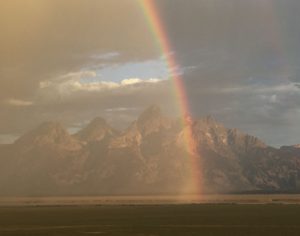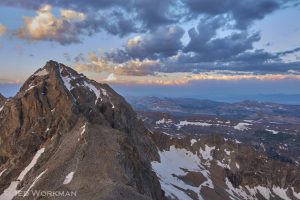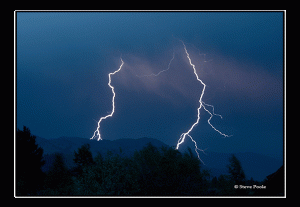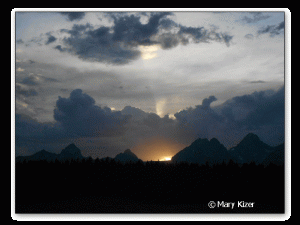All posts by Jim Woodmencey
Summer in Jackson Hole 2016, in Review
The Summer Forecast Was..
First though, let’s see how accurate the long-range predictions were for this summer. The National Weather Service’s Climate Prediction Center had forecasted back in April of 2016, that June-July-August over western Wyoming: a good probability of above normal temperatures, and a higher probability of having above normal precipitation.
Just for giggles, I also looked back at what the Old Farmer’s Almanac had predicted for our region, which was: a “Hot & Wet Summer”. That was in pretty good agreement with the Climate Prediction Center’s forecast.
Now, with the benefit of Bob Yaw’s hindsight forecasting, how would you describe this past summer? You might say that overall temperatures were “pretty warm”. But it certainly was not “wet”.
Let’s see what actually happened, by reviewing the data form the Jackson Climate Station, and comparing those numbers to the long-term historical averages.
This Summer Really Was…
June was the only month this summer with above average temperatures. And, it was much drier than normal. The total precipitation received was just 0.77 inches, which is less than half of the average precipitation amount for June of 1.63 inches.
July had much cooler than average high temperatures for the month, a solid four degrees cooler than the long-term average. Overnight low temperatures balanced that a little, they ended up two degrees warmer than normal.
Wait, I thought it was hot in July? Certainly, the last half of the month we heated up, with 13 out of 15 days registering high temperatures in the 80’s. However, the first half of the month took a toll on getting us anywhere near normal. Including a couple of exceptionally cold days around July 11th and 12th, with a high of 57-degrees followed by a low of 31-degrees. You might remember it also snowed down to near 8,000-feet in the Tetons.
August was also cooler than normal. The average high and low temperatures were each two degrees cooler than the long-term averages. You might find that surprising, as it sure seemed like it was hot in August, too. There were 12 days in August 2016 with highs in the 80’s, however, the remainder of the days had highs that were only in the 60’s or 70’s.
Overnight low temperatures in August also helped drag the overall average temperatures down. There were five days in August when temperatures dropped below the freezing mark, bottoming-out at 28-degreeson August 24th and again on August 27th, the coldest days of the summer.
Summer Summary
Each of the last three summers in Jackson has seen the overall average mean temperatures at or slightly cooler than normal. That should be encouraging to some, after a spate of warmer than normal summers earlier in the 2000’s.
This summer, the hottest temperature recorded in town was 88-degrees, on July 22nd and again on August 18th. Officially, it never made it to 90-degrees all summer. As a matter of fact, it has now been eight years since we have reached 90-degrees at the Jackson Climate Station. The last time it was “officially” 90-degrees in town was on August 1, 2008.
While the last three summers stayed cool, temperature-wise, this past summer was the only one of the last three that was drier than normal. Total precipitation in town this summer was a measly 1.90 inches, or around 50-percent of the long-term average. The two summers previous to this one were much wetter than normal, which helped keep hillsides green and fire danger relatively low.
Had it not been for wetter than normal conditions in April and May of 2016, we might have very well dried-up and blown away this year by September 1st.
Jim is the chief meteorologist at mountainweather.com and has been forecasting the weather in Jackson Hole and the Teton Mountains for almost 25 years.
Table:
Summer Weather Comparison
|
||||
| Summer 2016 |
Normal Summer | Summer 2015 |
Summer 2014 |
|
| Average High Temperature | 77 °F | 78 °F | 75 °F | 73 °F |
| Average Low Temperature | 39 °F | 39 °F | 42 °F | 41 °F |
| Mean Temperature | 58 °F | 58.5 °F | 58.5 °F | 57 °F |
| Precipitation | 1.90 inches | 3.77 inches | 4.67 inches | 4.40 inches |
| Data and Stats from Jackson Climate Station | ||||
Article re-printed from Mountain Weather column that appeared in the Jackson Hole News & Guide.
Rainbow Tetons

Morning Clouds from the Grand Teton.

Solar Eclipse Weather Pre-Check
 |
| Meteorologist Jim Woodmencey |
 |
| Visible Satellite Photo 21 August 2016 |
 |
| Locations of Large Forest Fires in Western U.S. August 2016 |
Playing it Safe During Thunderstorms
 |
| Meteorologist Jim Woodmencey |
 The most common cause of lightning casualties, however, comes from getting shocked by the high voltage current that runs through the ground. Ground current accounts for about 50-percent of all lightning casualties.
The most common cause of lightning casualties, however, comes from getting shocked by the high voltage current that runs through the ground. Ground current accounts for about 50-percent of all lightning casualties. Don’t wait for it to start raining before you think about seeking shelter, or for the first bolt to hit nearby, as most people tend to do.
Don’t wait for it to start raining before you think about seeking shelter, or for the first bolt to hit nearby, as most people tend to do.Jim is the chief meteorologist at mountainweather.com and has been forecasting the weather in Jackson Hole and the Teton Mountains for almost 25 years.
Watching the Sky for Thunderstorms
 |
| Meteorologist Jim Woodmencey |
1) How much moisture is in the air. 2) How unstable the air is.
1) The first puffs of cumulus appear before noontime.
Understanding Your Weather Prognosis
|
Probability of Precipitation
|
||
|
Probability
|
“Uncertain” Term
|
Alternate Description
|
|
10 to 20 %
|
Slight Chance
|
Isolated
|
|
30 % to 50 %
|
Chance
|
Scattered
|
|
60 % to 70 %
|
Likely or Possible
|
Widespread or Numerous
|
|
80 % to 100 %
|
No terms used, forecast just reads: “Rain”, “Snow”, “Thunderstorms”, etc.
|
|
The Early Winter Outlook
 |
| Meteorologist Jim Woodmencey |
|
NOAA Climate Prediction Center Three-Month Outlooks
|
||
|
Three-Month Period
|
Temperature
|
Precipitation
|
|
NOV-DEC-JAN
|
55% above
|
55% below
|
|
DEC-JAN-FEB
|
60% above
|
65% below
|
|
JAN-FEB-MAR
|
50% above
|
60% below
|
|
Probabilities from the new Experimental “Unofficial” Two-class Climate Outlooks
|
||
Hyper-El Nino may be Over-hyped
 |
| Meteorologist Jim Woodmencey |
(Note: The article in this post was originally published in the Jackson Hole News and Guide on August 19, 2015).
The comments and questions are starting to come more often now, about the current El Nino and how it will affect our winter. I blame the bigger media outlets for creating this hype, by attaching monikers to their headlines like: “Super El Nino”, “Strongest El Nino Ever”, and my personal favorite, “The Great Godzilla of an El Nino”.




